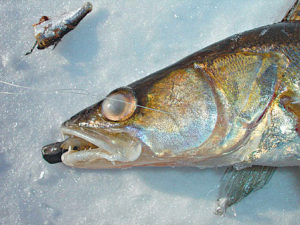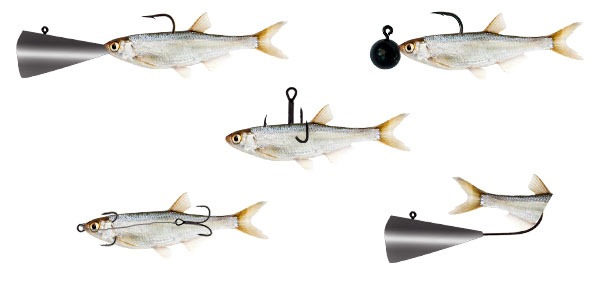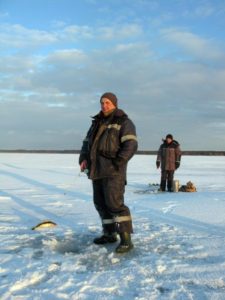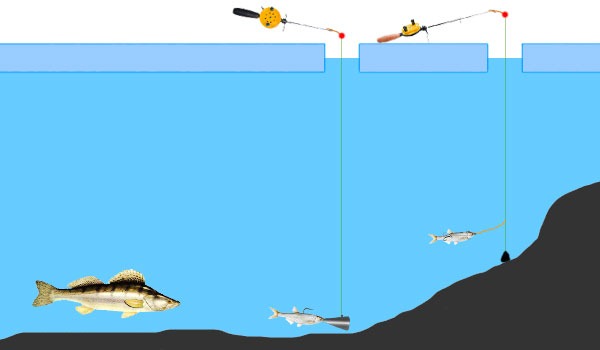Catching zander on sprat in winter
Zander fishing is considered one of the most popular winter fishing trips. Catching such a fish brings not only satisfaction, but also an adrenaline rush, especially when you hold a fish weighing more than 1 kilogram on the line. When fishing for zander, fishermen use tulle in different ways and, having certain knowledge and experience, as well as having studied the habits of a predatory fish, you can be content with the captured trophy.

Content
- 1 The specifics of catching zander on sprat in winter
- 2 Features of the harness for catching zander on sprat in winter
- 3 Where and when to catch pike perch on sprat in winter
- 4 How to catch on sprat: tactics and technique of catching zander on sprat in winter
- 5 Typical mistakes of catching zander on sprat in winter
The specifics of catching zander on sprat in winter
Given the fact that the reservoir is familiar and, guided by the behavior of the fish, you can immediately give a guarantee that half of the work is done. Since zander mostly hides in dumps or in places with a current and snag, fishing should take place 30 cm from the bottom of the reservoir, especially if there is a strong current.
Having found a fishing spot, you should start winter sprat fishing for pike perch. For this, tackle is lowered into pre-drilled holes, while making swings at a distance of 30 cm with 5-second pauses. The bait is played in such a way that it returns to the previous depth.
Worth knowing! When fishing with bait, you need to remember that it will go a long distance from the hole due to the current and it will be difficult to control the depth.
To elicit a reaction in the pike perch to a jig, it is imperative that it be covered with luminescent paint. It usually happens like this:
- the tulle is fixed by the tail;
- fix it in a semicircle, and cut the nozzle sharply.
Catching pike perch on sprat does not require basic costs: when fishing, the gain will be focused on live bait, and there is no need to waste time catching fry. You can buy it at a fishing store.
Note!Buying a cheap tulka is practically no different from expensive baits or wobblers.

Catching a zander in winter on a tulle without a properly equipped fishing rod will not work. And it is also not so easy to plant the tulka correctly. Inexperienced anglers try to choose fatter bait, relying on the fact that the larger the bait, the larger the fish can be caught. But if the tulka is more than 5 cm, the fanged fish does not completely swallow the bait, and then swims away. If the bait is attached to the tail, the pike perch will swallow it from the head and immediately find itself on the hook.
Features of the harness for catching zander on sprat in winter
Fishing success will depend on the right equipment. Having selected the necessary components of winter tackle for zander for sprat and, guided by knowledge of the reservoir and fishing technique, you can achieve good results.
- Rod. It must be strong enough to withstand the resistance of the fish while playing. An important condition in the rod is the cushioning of the whip for a powerful strike. The rigidity of the tackle will be a positive moment, especially for the period of piercing the predator's jaw. With soft tackle, you can pluck prey, which is not typical for an angler.
- Hooks. Their sting must be sharp and of high quality.
- Coil. It is better to pick up a large one without any mechanism, which will allow winding only on the hand. This will allow you to determine the topography of the reservoir.
- Nod. Made of steel and looks like a plate. Possesses high sensitivity. With its help, bite is determined. In contact with pike-perch, it determines the slightest movement of the tackle.
- Fishing line. Better to choose a monofilament line 0.35 mm. In rare cases, anglers use a braided line, but it freezes in the cold. Everything else, the braid forms knots, which makes it difficult to play.
- Leash. With the help of a knot, the bait is attached to the tackle, and the line remains free.
By the way! Installing metal leashes will be superfluous, as it can scare off the predator.
Video: catching pike perch on sprat - tackle
Catching zander in winter on sprat is carried out with four types of tackle. Each of them uses its own fishing rod and equipment.
Shine. This type implies artificial baits such as spinners or silicone. The tulle attracts the toothy hunter with the smell to the bait. A 70 cm rod with a strong whip and a cork handle, which does not freeze in the cold, and a light coil (preferably inertialess) with a small spool, are taken into the contents of the tackle. The line is approximately 0.3 mm. (monophilic).
Zherlitsa. The use of a zander when fishing for zander in winter on a sprat consists in the correct rigging. In case of a strong or insignificant current, the installation of the crosspiece is carried out from a fishing line of 0.3-0.4 mm, which is put on a sliding sinker. A silicone stopper is placed under the weight, with which you can change the distance of the line segment to the hook. At the end, a hook is tied, the appearance of which is due to the desire of the fisherman.
Video: catching pike perch and bersh in winter on sprat and zherlitsa
Mormyshka. Fishing is carried out using a fishing rod about 1 meter long. Fishing usually takes place while sitting or standing. The rod is equipped with large allowance rings and an inertial reel with a brake. If the jig is heavy, then the tulka is attached to the head or tail. When attached to multiple hooks, it is attached to multiple hooks.Jigs for pike perch in winter on sprat are a good solution for catching this predator.
Postavush. In principle, this is a kind of zerlitsa, only equipped with dead fish, and it is also suitable for catching zander on sprat in winter. The tackle is designed in this way: a jig is tied to the fishing line, then a small leash with a hook is tied at 30-40 cm, where the tulka is placed.
Video: catching zander in winter on a tulka with a lead from the ice
Where and when to catch pike perch on sprat in winter
Unlike pike, pike perch does not stand in one place, and their schools chase through a reservoir or other water area in search of small fish. Some fishermen even note that their movements look like a closed curve that passes through various places in the reservoir.
Usually pike perch roams in such locations, as:
- snag;
- pits;
- eyebrows;
- places with accumulations of stones;
- places where there is a sandy bottom;
- channel depressions;
- elevation of the bottom of the reservoir.
Important! Before fishing for a day or at least a few hours, you should feed the fishing spot, but do it so as not to overfeed the fish.
Zander used to to clean areas of the reservoir, and such places can be found either on your own, especially if the place is familiar, or you can ask local fishermen.

It should be noted that from the middle of winter the bite decreases, and it is difficult to find the fish, because it is half asleep. In this case, an echo sounder will help, which will determine not only the presence of fish, but also the depth with the relief of the reservoir. True, the acquisition of such a tool will require large investments.
Depending on the ambient temperature, the peak bites are in the morning and evening hours.
Unlike the day when the predator hides in the silt, at night it swims into shallow water, where it can be easily caught.
There are such reservoirs where fishermen occupy several fishing places, and some invite all friends to drill holes throughout the reservoir and thereby cover the area of the reservoir, while not allowing other wandering fishermen to visit.
In any case, it is imperative to practice the ability to catch pike perch on sprat in winter. The tackle described in the article will help you properly prepare for fishing. And in the end the bite and catch will be secured.
Video: catching winter pike perch on sprat
How to catch on sprat: tactics and technique of catching zander on sprat in winter
Anglers have many learned and learned tactics. Some are accustomed to drilling many holes and checking for bites in them, trying to cover most of the water area, while others know exactly where to look for a predator and at what time to fish. Everyone's tactics can be unpredictable, because everything will depend on the place of fishing and the frequency of the bite.

As a recommendation, anglers use the following proven tips when fishing for zander in winter on sprat:
- painting the jig heads with fluorescent paint will bring the maximum number of bites;
- correct rigging and master feeding with subsequent control of live bait will lead to the catch of a large trophy;
- hooking should be done sharply so that the hook can go deeper into the fish's mouth;
- with the help of the hook, you can pull the predator onto the ice, while it will not break off at the right time and will not catch on the ice;
- a significant number of bites can be carried out by experiment.
Typical mistakes of catching zander on sprat in winter
Many people do not have enough knowledge of catching zander on sprat, and often anglers make the same mistakes. In order to prevent them in the future, it is worth starting from the experience of experienced fishermen. Below are the main mistakes that can be made not only by a beginner, but also by an avid ice fishing fan:
- using more hooks or jigs will not increase the bite;
- with a lot of hooks, one of them can catch on the edge of the ice, and then the planted fish can break off;
- improper play with tackle in the current can disrupt the bite, so it is worth mounting a drop-stop with a diverter leash and sticking a sprat instead of artificial baits;
- if several gears are located far from each other, the hook will be disrupted;
- an incorrectly planted tulle can ruin energetic play.
As you can see from the article, catching a winter pike perch on a sprat is not particularly difficult. Guided by the knowledge of the reservoir and having carried out fishing techniques or experimenting with certain gear, you can catch an excellent trophy that you can boast to family and friends.

